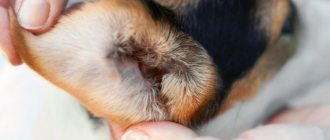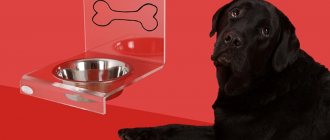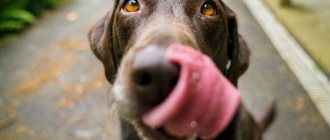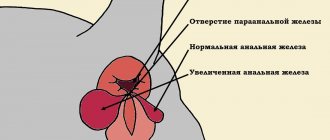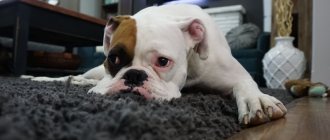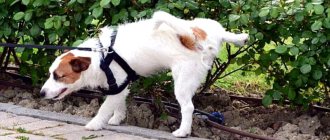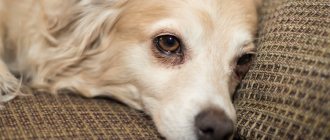The large size of an animal cannot guarantee its good health. Quite often, it is dogs of large build who experience problems in the body. One of these problems is associated with the pathology of the musculoskeletal system – dysplasia. Heavy weight, massive build and excessive physical activity often lead to joint problems. An experienced specialist is able to identify such a pathology even in puppyhood, which helps prevent further complications. In its advanced state, the disease leads to complete paralysis of the dog’s limbs.
Characteristic features of the disease
Dysplasia is a pathology that destroys or modifies articular tissue, associated with improper fit of the head of the bone to the glenoid cavity. In a healthy dog, the fit is quite tight, ensuring smooth gliding and elasticity of this design. With dysplasia, there is a gap between the bone and the niche where it fits, this causes friction of the tissues, leading to their separation and flattening. Subsequently, the articular cartilage succumbs to strong pressure and becomes deformed.
The described disease is not congenital, but quite often develops in early childhood. By taking an x-ray, the veterinarian can easily determine the presence of dysplasia even at the initial stage. In the absence of proper attention, pronounced symptoms and deformation of the musculoskeletal joint become noticeable by the year of the dog’s life. In the period from one to one and a half years, the structure of the body is formed and its intensive growth ends; during this period it is easy to determine the condition of the pet’s joint tissues.
Dogs of large breeds are predisposed to the appearance of this pathology - St. Bernards, shepherds, retrievers, Labradors and others. Dysplasia affects various groups of joints of the musculoskeletal system and is divided into several types:
- Damage to the hip joint (HJ) is the most common form, due to the peculiarity of the hind legs of dogs. When running or jumping, the dog leans and pushes off with its hind legs, using them as shock absorption.
- Elbow joint damage is abnormal growth of tissue cells in the elbow or knee area and is the main cause of severe lameness and chronic pain in your pet.
- Damage to the knee joint is a rare type, associated with improper care and maintenance of the animal, or a previous injury.
What is this?
Joint dysplasia is the abnormal formation and development of joints, leading to impaired mobility and degenerative changes. In the initial stages, the disease entails deformation of the pet’s joint and then bone tissue.
An incorrectly formed or damaged joint, when rubbed, “erases” the cartilage tissue, causing severe pain. Gradually, the process affects the health and strength of the bones, preventing the dog from fully moving and leading an active lifestyle.
Note! According to statistics, dysplasia usually affects the hip joints. This is due to the fact that they bear the greatest load when running and jumping.
Causes
The appearance of pathology in a dog is almost always associated with a genetic predisposition to this disease. If the mother or father of the puppy has suffered from pathology or are carriers of a harmful gene, the puppy automatically falls into the risk group. He may not get sick himself, but he will pass this gene on to his offspring. However, proper maintenance and care do not guarantee that the pet will not suffer from the disease.
In addition to hereditary predisposition, there are a number of factors that lead to this disease and provoke its intensive development:
- unbalanced diet - low-quality food, excess protein, limited menu variety (consumption of only meat), over time this diet leads to severe joint pain in the pet
- excess protein and calcium – the use of food supplements with these elements leads to a rapid increase in the pet’s muscle mass, while the bones and joints do not have time to develop and strengthen properly for the animal’s gained weight
- intense physical activity that is unsuitable for a dog due to age or ability leads to gradual destruction of the joints
- a sedentary lifestyle contributes to improper development of joints
- excess weight – leads to increased load on the joint tissue, leading to its gradual deformation and destruction
- previous injuries - paw dislocations, bruises, sprains
Symptoms
Almost all cases of the disease in dogs appear at an early age, not exceeding one and a half years. This is due to the intensity of growth and weight gain in a given period. An attentive owner can independently determine the presence of pathology by a number of symptoms - they may differ slightly, which is associated with the area of damage to specific joints.
Damage to the hip joints:
- pronounced wobbling when walking, difficulty climbing stairs and hills
- leading the dog in a horizontal position for a long time, with its paws spread
- severe fatigue when walking, use of four paws when pushing off while running - “rabbit running” syndrome
- lameness affecting one or both hind legs of a dog
Damage to the elbow joints:
- severe lameness of the front legs, difficulty descending stairs
- hardening, swelling of the joints
- a feeling of discomfort and pain when walking or running, the pet may whine or react aggressively to an attempt to touch the paw
- slowness of movement or complete refusal to walk
Common symptoms include:
- asymmetry of the pet’s body due to redistribution of the load on the paws
- pronounced limp and swaying
- frequent resting, incorrect positioning of paws, stiffness of movements
- unnatural posture when resting
- severe swelling in the affected area, pain when palpating this area
Timely detection of this problem and contacting a specialist greatly facilitates the treatment of your pet. In this case, the veterinarian has a better chance of a quick recovery and restoration of the dog. Advanced dysplasia is less treatable.
Paresis and paralysis (plegia) in dogs
Depending on the depth of the disorders and the degree of loss of limb function, paresis and paralysis, or plegia, are distinguished.
Paresis
- This is a weakening of voluntary movements. Plegia (paralysis) is a complete inability to make voluntary movements.
Paresis can be:
- partial (outpatient) - voluntary movements are impaired, but the dog is capable of moving;
- complete (non-ambulatory) - control over voluntary movements is completely lost; with paraparesis, the animal can only move by dragging its hind end.
Such an assessment may be somewhat subjective, but it helps to most fully describe the clinical picture in each specific case.
Depending on the level of damage to the spinal cord and the involved limbs, there are:
- paraparesis (pelvic limbs involved);
- tetraparesis (all four limbs are involved);
- monoparesis (only one limb is affected);
- hemiparesis (extremities on one side of the body are affected).
Similarly, para-, tetra-, and monoplegia are distinguished.
Diagnostics
Prescribing treatment on your own is unacceptable and can lead to serious problems. Only a specialist can determine the exact diagnosis and its stage of development. Diagnosis of the disease involves a visual examination of the animal. The veterinarian conducts a mobility test - flexion, extension of the joints and listening to sounds (clicks, squeaks, friction) during this process. This stage allows you to determine the presence of pathology.
To clarify the degree of joint deformation, an x-ray is prescribed. It is performed under anesthesia to ensure complete immobility of the patient. The finished image allows you to determine the exact location of the glenoid cavity and the head of the bone.
A more accurate examination of damaged joints is carried out using arthroscopy. The procedure allows you to examine the tissue structure using a miniature camera inserted into the joint cavity with a small puncture. Such research is highly accurate and informative. But it can only be carried out in modern, technologically equipped clinics.
After all the research, the specialist determines the degree of dysplasia. The general condition of dog joints is divided into several categories:
- A (no obvious signs of disease)
- B (predisposition to pathology)
- C (initial stage of the pathological process)
- D (presence of violations within the acceptable limits)
- E (severe deformation of articular tissues)
What actions to take
With the above-mentioned symptoms, it is impossible to provide independent treatment for the animal, since it is necessary to take a blood test to identify the presence (or absence) of internal inflammatory processes in the animal. If there is pain in the paws and spine, an x-ray must be taken immediately. The obvious presence of bloody impurities in a dog’s urine is an abnormal phenomenon, and drinking too much is a consequence of dehydration from bowel disorders. We consider it mandatory advice to take your pet to the veterinarian as soon as possible for emergency care.
Treatment
The described pathology is treated by two methods - medication and surgery. The chosen method depends on the individual characteristics of the animal, the degree of disease, the age category and body weight of the dog. The speed of development of the pathology and the general well-being of the pet are also important.
Conservative treatment includes several components. First of all, medications of various action groups are prescribed:
- chondroprotectors - the effect is aimed at stopping pathological changes and restoring affected tissues, drugs are administered intramuscularly, intravenously or directly into the joint itself
- anti-inflammatory drugs – relief of inflammation
- antispasmodics – reduction of pain, relief of general condition
- homeopathic medicines – have a supportive, preventive effect
- food supplements containing glucosamine and chondroitin help strengthen bone tissue and regenerate joints
Along with medications, physiotherapy is prescribed. If necessary, paraffin therapy, ozokerite, magnetic and laser therapy are prescribed. Massage of affected joints has a positive effect. But only a competent specialist can perform it, determine the number of necessary sessions and their duration. For treatment to be effective, moderate physical activity is required - swimming, walking, light jogging.
Don't forget about your pet's diet. This is of particular concern if the disease is acquired due to obesity. It is important to get rid of excess weight; the dog is put on a low-calorie diet and the weight loss process is monitored. During this period, vitamin complexes are necessarily used.
If the disease is severe, conservative treatment will not have the desired effect, and the pet’s condition may worsen significantly. In this case, the optimal solution is surgery to correct the shape of the head of the bone to ensure a tight fit to the glenoid cavity.
Before the operation, a repeat x-ray is prescribed. The complexity and duration of the procedure directly depends on the severity of the disease. In the simplest version, cartilage removal will be required. In severe cases, one of the following types of surgery is prescribed:
- Arthroplasty is complete or partial excision of the head and neck of the femur. The procedure is prescribed for advanced stages of the disease with irreversible consequences when the disease develops into osteoarthritis. During the operation, no prosthetics are implanted into the body. Rehabilitation takes a long period of time, but after it is over, the pet completely forgets about the disease.
- Osteotomy is a surgical procedure that involves changing the position of the articular cavity. As a result, the head of the bone takes the correct position in the joint, restoring the position of the limb. The operation is performed at the initial and mild stage of the pathology.
- Endoprosthetics is the replacement of affected joints with prostheses made of titanium alloy. There is a risk that the body may reject the prosthesis, but in most cases they take root successfully. The operation process is quite complex and lengthy, as is the rehabilitation process. But with full recovery, the dog will be able to move calmly without experiencing discomfort and return to moderate exercise.
Disease prevention
A number of preventive measures will help to avoid the occurrence of pathology:
- exclude excessive physical activity, which is especially important during the period of active growth of the puppy
- maintain a proper diet, do not overfeed the animal
- carefully monitor your dog's weight
- ensure sufficient physical activity of the pet
- Visit your veterinarian periodically to diagnose his condition
It should be remembered that puppies with a genetic predisposition to the disease are always at risk. They require stable periodic examination by a specialist.
